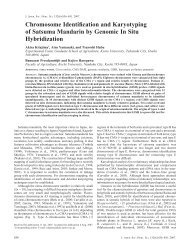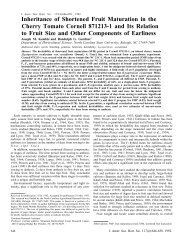Dehydrator Onion Bulb Weight and Water-soluble Carbohydrates ...
Dehydrator Onion Bulb Weight and Water-soluble Carbohydrates ...
Dehydrator Onion Bulb Weight and Water-soluble Carbohydrates ...
Create successful ePaper yourself
Turn your PDF publications into a flip-book with our unique Google optimized e-Paper software.
State Univ. breeding line, ‘NM9335’, were chosen for this study.<br />
The GS02 <strong>and</strong> GS04 cultivars are proprietary cultivars that are used<br />
in commercial dehydrator onion production in California. The<br />
NM9335 dehydrator onion breeding population was an openpollinated<br />
F7 generation that originated from the cross of ‘Ben<br />
Shemen’ x ‘Southport White Globe’ <strong>and</strong> had one previous selection<br />
cycle for SSC. The NM9335 population was well adapted to the<br />
experimental location, which was indicated by vigorous growth,<br />
large bulbs, <strong>and</strong> disease resistance. The GS02 <strong>and</strong> GS04 cultivars<br />
had relatively small bulbs that had more symptoms of pink root<br />
(Phoma terrestris Hansen) <strong>and</strong> fusarium basal rot [Fusarium<br />
oxysporum f. sp. cepae (Hans) Snyder <strong>and</strong> Hansen], relative to<br />
NM9335.<br />
FIELD EXPERIMENTS. Experiments were conducted in 1994 <strong>and</strong><br />
1995, <strong>and</strong> were located at the Fabian Garcia Agricultural Science<br />
Center in Las Cruces, N.M. A split-plot experimental design with<br />
six replications was used for bulb characteristic studies before <strong>and</strong><br />
after maturity. <strong>Onion</strong> populations were planted in rows to form main<br />
plots, <strong>and</strong> maturity treatments were applied as subplots within rows.<br />
A r<strong>and</strong>omized complete block design with six replications was used<br />
for plant-weight partitioning studies of the GS04 cultivar. Plots were<br />
established 1.1 m long, with a 1-m row spacing, <strong>and</strong> with four<br />
equally spaced lines of plants direct-seeded in a 76-cm-wide bed on<br />
26 Jan., both years. Seedlings were h<strong>and</strong> thinned to 6 cm between<br />
plants at four weeks after emergence. The crop was managed<br />
according to st<strong>and</strong>ard practices for southern New Mexico, with<br />
water <strong>and</strong> nitrogen applied using drip irrigation (Bailey <strong>and</strong> Corgan,<br />
1986; Corgan <strong>and</strong> Kedar, 1990). Plots were considered mature when<br />
≈80% of the tops had fallen. Predicted <strong>and</strong> actual maturity closely<br />
coincided both years. The NM9335 population matured on 15 July<br />
1994 <strong>and</strong> 10 July 1995. The GS02 cultivar matured on 13 July 1994<br />
<strong>and</strong> on 7 July 1995, <strong>and</strong> the GS04 cultivar matured on 7 July 1994<br />
<strong>and</strong> on 20 July 1995. <strong>Onion</strong> bulbs were h<strong>and</strong> harvested from within<br />
the middle 0.9 m of the plot. <strong>Onion</strong> roots <strong>and</strong> tops were clipped at<br />
harvest, diseased bulbs were discarded, <strong>and</strong> harvested bulbs were<br />
stored temporarily in paper bags at ambient air temperature (≈25<br />
°C). <strong>Bulb</strong>s were left rooted in place with tops attached, for postmaturity<br />
harvest treatments. During 1994, treatments were designed to<br />
harvest plots at 45, 30, <strong>and</strong> 15 d before maturity, at maturity, <strong>and</strong> at<br />
15, 30, <strong>and</strong> 45 d after maturity. The 45 d treatments were omitted<br />
from the 1995 experiments.<br />
On the day of harvest, <strong>and</strong> just before testing, bulbs were washed<br />
<strong>and</strong> dried to remove soil <strong>and</strong> dry scales, top <strong>and</strong> root stubble were<br />
removed, <strong>and</strong> fresh yield data was obtained from these samples.<br />
Samples of GS04 plants were prepared for weight partitioning<br />
studies by cutting 10 plants from each replication into leaves,<br />
pseudostems, <strong>and</strong> bulbs. Percent dry weight was determined by<br />
h<strong>and</strong> chopping the 10-bulb subsample <strong>and</strong> the plant parts into coarse<br />
pieces (≈2 to 3 cm), which were then dried at 100 °C for 1 h, <strong>and</strong> then<br />
at 70 to 75 °C for 48 h, in a forced air convection oven. Dried samples<br />
were frozen at –10 °C subsequent to WSC analysis using HPLC.<br />
Average bulb fresh weight was calculated by dividing plot fresh<br />
yield by the number of bulbs per plots. Average bulb dry weight was<br />
calculated by multiplying average bulb fresh weight by average bulb<br />
percent dry weight.<br />
WATER-SOLUBLE CARBOHYDRATE ANALYSIS. HPLC analysis was<br />
conducted according to the modified methods of Suzuki <strong>and</strong> Cutcliffe<br />
(1989) <strong>and</strong> Scobell et al. (1977), <strong>and</strong> four replications of each field<br />
treatment were analyzed. Dried bulb samples were further prepared<br />
by chopping <strong>and</strong> mixing in a food processor, <strong>and</strong> then 20 to 30 g of<br />
these flakes were ground into powder to pass through an 80 mesh<br />
screen. Powder was mixed with triple distilled water (1 g/100 mL)<br />
<strong>and</strong> shaken for 1 h at 25 °C. Solutions were vacuum filtered through<br />
#40 filter paper, <strong>and</strong> then refiltered into HPLC vials through a 45 μm<br />
membrane filter disc. The vials were sealed <strong>and</strong> then immediately<br />
stored at –10 °C before HPLC analysis.<br />
<strong>Carbohydrates</strong> were analyzed by injecting 20 μL of sample<br />
solution into a Hewlett-Packard 1090 series liquid chromatograph<br />
with deionized, distilled, degassed water as the mobile phase, <strong>and</strong> an<br />
ion moderated partition column (Bio-Rad Aminex HPX-42A, Hercules,<br />
Calif.) as the stationary phase, followed by a Hewlett Packard<br />
1047A refractive index detector. A flow rate of 0.6 mL·min –1 <strong>and</strong> a<br />
column temperature of 85 °C were used.<br />
Glucose, fructose, <strong>and</strong> sucrose st<strong>and</strong>ard sugars were used to<br />
calculate column retention times for these onion WSC. Highfructose<br />
corn syrup oligosaccharide st<strong>and</strong>ards indicated the column<br />
was detecting polysaccharides in sequential rank of degree of<br />
polymerization (DP), which infers that onion fructans also elute in<br />
sequential rank of DP. Quantitative analysis of onion WSC was not<br />
possible because fructan st<strong>and</strong>ards were not available. Previous<br />
research on onion WSC confirms that glucose, fructose, sucrose <strong>and</strong><br />
fructans are the only constituent WSC carbohydrates found in<br />
Allium cepa L., <strong>and</strong> that fructans elute in sequence, based on rank of<br />
fructan DP (Darbyshire <strong>and</strong> Henry, 1978, 1979). Based on these<br />
assumptions, relative amounts of WSC were estimated from peak<br />
Fig. 1. <strong>Bulb</strong> weight characteristics of three dehydrator onion populations before <strong>and</strong><br />
after maturity, averaged over 1994 <strong>and</strong> 1995.<br />
582 J. AMER. SOC. HORT. SCI. 124(6):581–586. 1999.<br />
weight
















